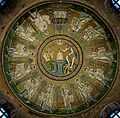Arianism facts for kids

Arianism was a set of beliefs taught by Arius, a priest from Alexandria in ancient times. Many Christians at the time thought these teachings were wrong or heretical. Because of this, Arianism is not practiced much today. However, Arians were a very important part of Christianity from the 4th to the 7th centuries AD.
Arianism mainly taught that Jesus was not God in the same way God the Father is. This idea went against the common Christian belief in the Holy Trinity. The Trinity teaches that God is one being in three "persons": God the Father, God the Son (Jesus), and the Holy Spirit. In 325 AD, a meeting called the First Council of Nicaea created the Nicene Creed. This creed helped early Christians explain their beliefs and challenge Arianism. It stated that Jesus, the Son of God, was "begotten, not made, consubstantial with the Father." This means Jesus was of the same divine nature as God the Father.
What Did Arians Believe?
The biggest difference between Arianism and other Christian groups was their view on the Holy Trinity. Arians did not believe in the Trinity, which is how most Christian churches explain God. What we know about Arian beliefs comes mostly from writings by people who disagreed with them. These writings tell us that Arians believed:
- Only God the Father is truly God. He was not created and has always existed. He never changes.
- God did not create the world all by himself. He had help from someone called Logos (which means The Word). This Logos was created by God to help make the world. It was like God's way of "communicating" with the world.
- This "Son of God" or "Christ" existed before he helped God make humans. He was a perfect reflection of God the Father. But, unlike God the Father, he was created by God's will. This happened at the very beginning of time. So, he wasn't eternal like God the Father. There was a time when he did not exist. Also, his power, wisdom, and knowledge were not limitless.
Between the First Council of Nicaea in 325 AD and the First Council of Constantinople in 381 AD, Arians used many different creeds (statements of belief). There were at least 18 different ones.
Similar Beliefs Today
In the 16th century, new movements appeared that also questioned the idea of the Trinity. Fausto Sozzini (1539-1604) and Ferenc Dávid (1510s - 1579) were important teachers in this movement. These ideas later led to what is now called Unitarianism. Unitarians believe that God is only one person, not three persons in one, as the Trinity teaches.
Some teachings of Jehovah's Witnesses are similar to what Arians believed. However, they are different because Arians believed the Holy Spirit was a person, while Jehovah's Witnesses teach it is not a person, but a force God uses. So, it would be wrong to call them Arians, as they do not agree with many Arian teachings. Mormons and Oneness Pentecostalism also do not believe in the Trinity, but their reasons are different from Arianism.
Images for kids
-
Imagined portrait of Arius; detail of a Cretan School icon, c. 1591, depicting the First Council of Nicaea.
-
Constantine burning Arian books, illustration from a compendium of canon law, c. 825.
-
Once the orthodox Trinitarians succeeded in defeating Arianism, they censored any signs that the perceived heresy left behind. This mosaic in Basilica of Sant'Apollinare Nuovo in Ravenna has had images of the Arian king, Theoderic, and his court removed. On some columns their hands remain.
-
The ceiling mosaic of the Arian Baptistery, built in Ravenna by the Ostrogothic King Theodoric the Great.
-
Page from the Codex Argenteus, a 6th-century illuminated manuscript of the Gothic Bible
See also
 In Spanish: Arrianismo para niños
In Spanish: Arrianismo para niños






